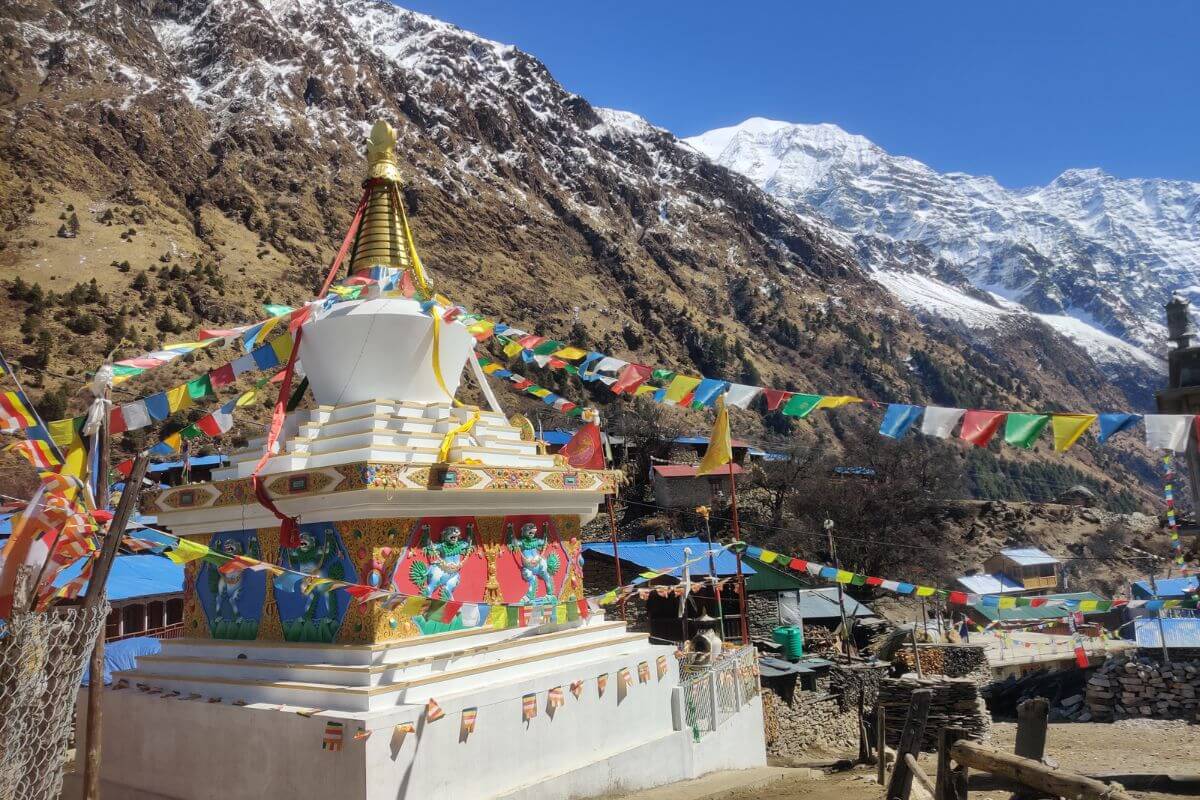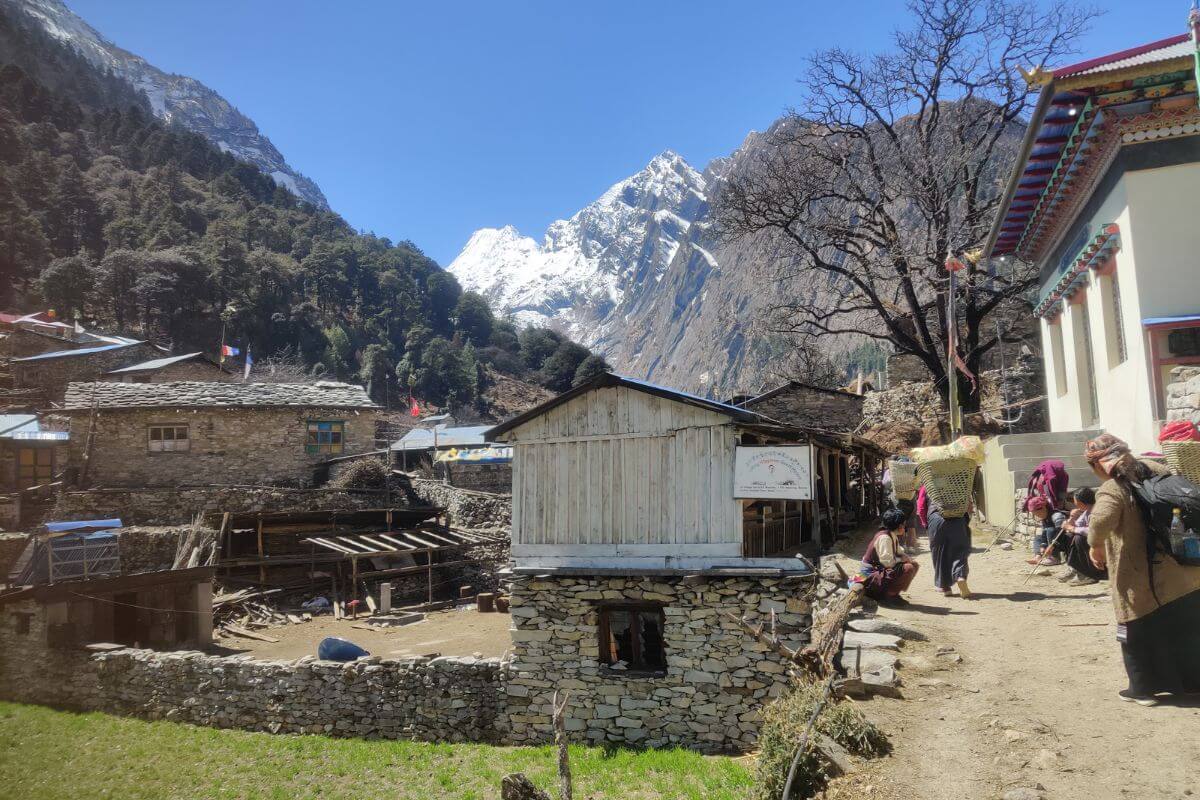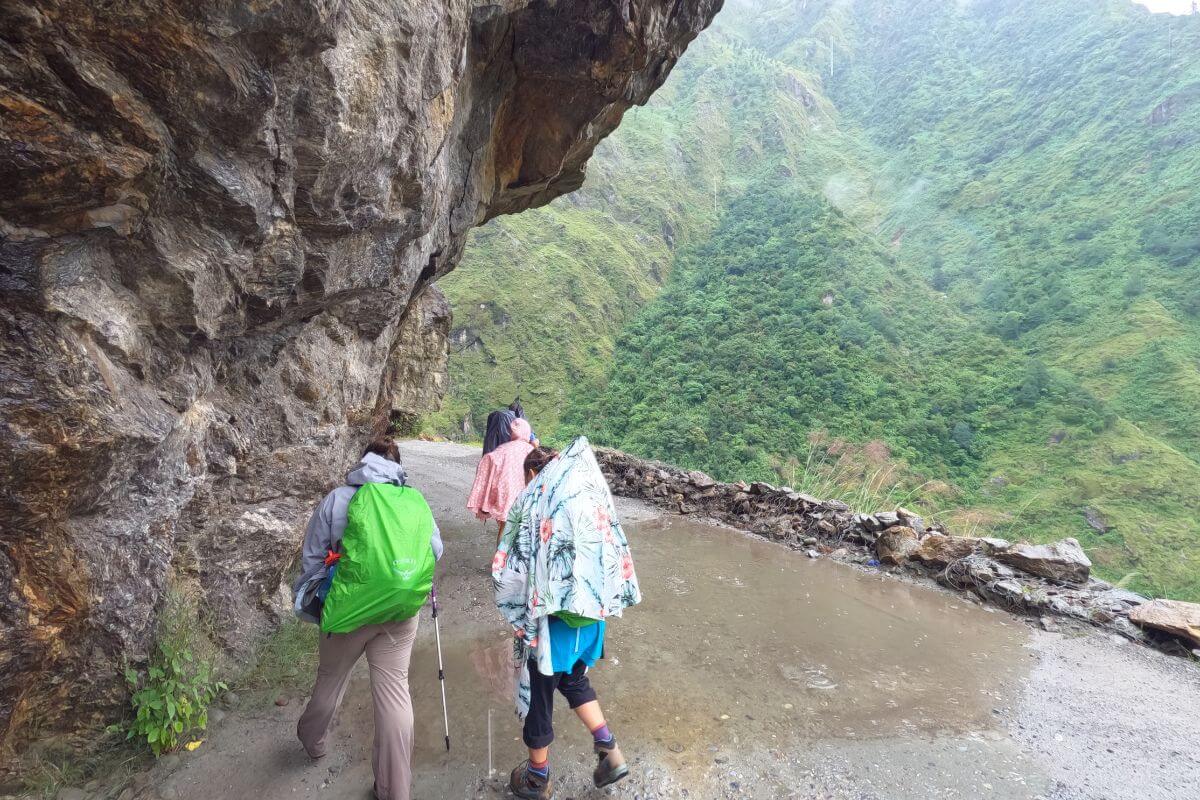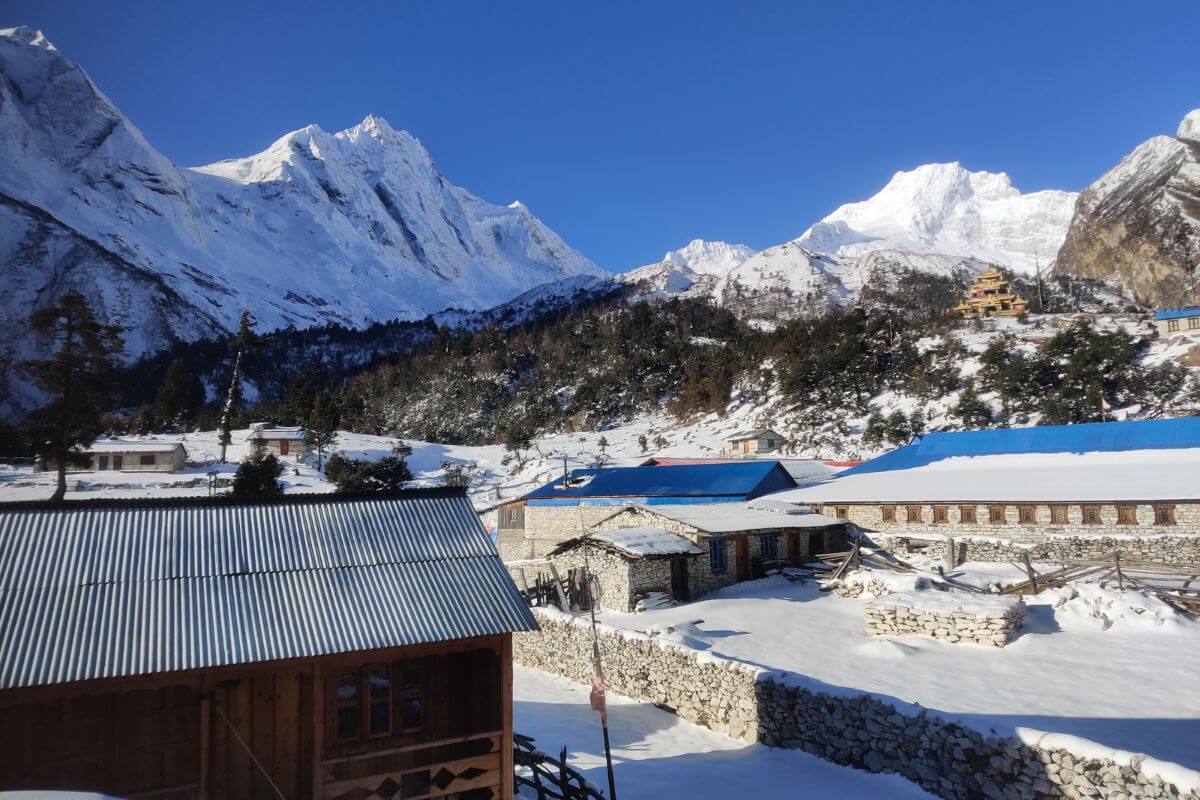The Manaslu Circuit Trek provides a stunning view of Mount Manaslu (8,163 m), which is located in the Gorkha district of Nepal. The circuit route takes around 14-18 days to complete while covering an altitude of 600 meters from Soti Khola to 5,160 meters at Larkya La Pass. The best times to go trekking are spring (March to May) and Autumn (September to November), when the weather conditions are optimal, providing the safest experience.
Choosing the Best Time for Manaslu Circuit Trekking
Table of Contents
Manaslu Circuit Trek Overview
Choosing the right trekking season for the Manaslu Circuit trek is essential for a safe and enjoyable experience. The Manaslu region consists of traditional villages, mountain passes, and diverse terrains, where weather conditions play a crucial role. Due to various seasonal differences in the area, trekkers are subject to difficulty and discomfort.
Mostly, trekking in the spring and autumn seasons is considered best for the Manaslu Circuit Trek. These seasons offer stable weather conditions, clear mountain views, and moderate temperatures, providing a comfortable walking experience.
Meanwhile, trekking the Circuit route during both summer and winter is also possible; however, trekkers may need to face some hardships. Summer and winter are considered off-season periods for trekking, which can bring heavy snowfall, icy trails, landslides, floods, and extreme cold conditions.
Trekking during these months is challenging and potentially risky. So, trekkers signing up for the trip must be aware that the overall experience can vary. Therefore, selecting the right season is crucial for a safe and comfortable adventure.

When is the best time to go on the Manaslu Circuit?
Spring (Mar-May) and Autumn (Sep-Nov) are the best months to hike this circuit.
The spring time is March to May, and Autumn is September to November. These seasons often have a high number of trekkers on the route. The temperature is moderate, and the weather is calm without any extremes. Both spring and Autumn are absolutely safe seasons for trekkers, making it the right choice for committing to this trek.
Spring (March – May): Witness the blooming of flowers and stable weather
Spring is one of the best times to commence the Manaslu region route. The weather is mild with great mountain views, which makes the journey safe and enjoyable. The spring season is marked by blooming rhododendron, which adds vibrant colors to the landscape. The colorful flowers and lush greenery welcome trekkers along this trek with a magical atmosphere.
Among the spring months, April tends to be the busiest. The accommodation options during April can get crowded. But the stable weather and stunning mountain views make the visit worthwhile. Trekkers need to pack light to medium-layer clothes, including a fleece jacket, a sun hat, sunscreen, and trekking poles. And a light rain jacket for late May showers.
But overall, the natural beauty of spring, followed by the pleasant temperature, gives way to an unforgettable scenery. Blooming rhododendrons on the backdrop of Manaslu, Cheo Himal, Kang Guru, and Himlung is a sight that spring welcomes in the Manaslu region.
Pros:
- Trails are marked with blooming rhododendron and lush landscape.
- Mild weather conditions are perfect for comfortable walking.
- Moderate crowds compared to Autumn.
- Great mountain views.
- Teahouses are fully operational.
Cons:
- Chance of snowfall at higher elevations.
- The weather can be unpredictable with occasional rainfall.
- Less visibility as compared to Autumn.

Summer / Monsoon (June – August)
Summer or Monsoon brings heavy rainfall and hot, humid conditions. The lower region of Manaslu becomes challenging due to the hot climatic conditions, and the higher region becomes icy. The slippery trails and abundance of leeches are another challenging factor for the monsoon hike. Due to excessive rainfall, most areas of Manaslu are also prone to natural disasters like landslides and floods.
But the summer trek is challenging, yet rewarding. There are fewer travelers on the Manaslu region trekking route, which provides an essence of solitude and peace. Trekkers will have plenty of time to bond with nature. The hills and valleys turn vivid with most of the scenery, including misty mountains.
Hikers need to pack essential items to prepare accordingly for the Monsoon trip. Some gears include a waterproof jacket, pants, quick-dry clothes, insect repellent, gaiters, sturdy waterproof boots, and rain covers for the backpack.
Pros:
- Trails are incredibly lush and green.
- Waterfall, rivers, and other water resources are at their peak.
- Very few travelers on the trekking trail.
- Sense of peace, solitude, and a chance to bond with nature.
- Lower costs due to a low number of trekkers.
Cons:
- Heavy rainfall can cause floods and landslides.
- Muddy trails and an abundance of insects and leeches.
- Limited teahouse access.
- Foggy, gloomy weather, so mountain visibility is poor.
- Slippery trails increase risks and potential danger.

Autumn (September – November): Festival vibes and can expect clear visibility of the Mountains
Autumn is the best season among all the other seasons for trekking in Nepal. The autumn season offers clear skies and unparalleled mountain views. The autumn days are warm and nights are cool, offering a comfortable walking and resting experience. Due to this reason, the autumn season is the peak trekking season of Nepal.
The season also incorporates major festivals of Nepal, including Dashain and Tihar. So, hikers get to immerse themselves in the festive environment, thereby understanding the culture and tradition of the Nepalese.
However, with the suitable conditions, the trekking trails are busy. A large number of visitors on the Circuit trek often have limited accommodation. The teahouses and lodges can also charge higher due to the overcrowding. So, visitors are recommended to book early to secure accommodation at a cheaper price.
According to the weather, trekkers need to pack layered clothes, including a base layer, fleece, and a down jacket. Trekkers also need good trekking boots, gloves, a hat, UV sunglasses, and trekking poles, which can ease the walk during the route. So, join for a vibrant atmosphere of Autumn which includes blue skies, mountain views, and festive vibes like nothing before.
Pros:
- The best time for the Manaslu Circuit journey is among all the seasons.
- Clear sky, excellent visibility, and moderate temperature.
- Cultural immersion in festivals, including Dashain and Tihar.
- Best for photography due to bright skies and crisp landscape.
Cons:
- Crowded season with a heavy number of hikers.
- Limited availability of accommodation, so booking in advance is necessary.
- Higher cost due to a high number of travelers.
- More time to acquire flight tickets, permits, and other logistic documents.

Is it worth doing the Manaslu Circuit during Winter? (December – February)
The Circuit is very challenging during winter. However, the challenge does come with a spectacular reward. During the winter months, hikers need to face cold weather conditions with freezing temperatures. The winter season is not recommended for beginner trekkers due to the difficulty in navigation, so only experienced hikers are found on the trail.
The higher altitude, especially, is painted white with thick snow and ice around the Manaslu area. However, on a clear day, the mountain views are spectacular, with one of the best views of the year. With most of the travelers avoiding the winter walk in Manaslu, you will find the trail quiet and peaceful. The remote nature and untouched beauty of Manaslu are truly portrayed in winter.
Pros:
- Solitude and an opportunity to be close to nature.
- Best view of snowcapped mountains and landscape.
- Authentic cultural encounters with minimal tourist crowds.
Cons:
- An extreme cold climatic condition that tests your endurance.
- Snow blockage at higher altitudes, especially at Larkya La Pass, requires a buffer time.
- Accommodation options may remain closed due to extreme cold climatic conditions.
Manaslu Trip Packing List During Winter: Be sure to carry a Heavy down jacket, thermal base layers, insulated gloves, a warm hat, a sleeping bag (-15°C), crampons/micro spikes, and extra-thick socks to cope with winter.
Is it worth doing the Manaslu Circuit during Winter: Absolutely, the Circuit expedition during winter is best suited for experienced trekkers, not beginners. If you are not bothered by the harsh cold conditions or are looking for a challenge, then the winter trip is the best option. The snow-capped landscape will surely make the trek unforgettable.
Budget tip: Due to a smaller number of hikers in winter, the budget is drastically reduced in the area. The lower demand is apparent, so the costs and availability of accommodation in the season will change. For a complete cost breakdown, check our Manaslu Circuit Trek Cost.

Importance of choosing the right season
Choosing the right season can provide a comfortable, risk-free, and enjoyable adventure. However, if not properly selected, trekkers may be prone to health issues and other dangers. Weather conditions, trail conditions, and crowd levels are some of the factors to consider before choosing the best season. So, plan to ensure the best view and a safer adventure.
Weather, Crowds, Pros & Cons by Month
Here is a complete month-by-month breakdown of the Circuit weather conditions. The illustrated table includes atmospheric factors such as temperature, rainfall, weather conditions, and crowd levels. Additionally, we have listed a few pros and cons for each month to assess suitability.
| Month | Temperature (°C) | Rainfall (mm) | Weather Condition | Crowd Level | Pros | Cons |
| January | -5 to 10 | 20 | Freezing month, dense layer of snow, clear skies | Low | Quiet trails, with great mountain views | Extreme cold conditions, snow blocked passes, and difficult navigation |
| Feburary | -3 to 12 | 25 | Cold, dry, and mostly sunny | Low to medium | Peaceful with excellent visibility | Cold climatic conditions, few accommodation options |
| March | 0 to 15 | 30 | Cold but starts to get warm, with only occasional snow | Medium to high | Blooming rhododendron | Variable snow at high passes |
| April | 5 to 18 | 40 | Moderate, dry, and clear skies | Medium to high | Best view, pleasant weather, comfortable walking | Slightly crowded, busy accommodation option |
| May | 8 to 20 | 60 | Warm with very low chance of rainfall | Medium to high | Vibrant landscape, moderate climate, safe trails, | Pre monsoon shower, moderate crowds |
| June | 10 to 22 | 200 | Start of monsoon, frequent rain | Low | Few travelers, lush landscape | Slippery trail, risk of landslide, flood |
| July | 12 to 22 | 250 | Heavy rainfall, gloomy, cloud cover | Low | Solitude, lush greenery | Dangerous trail, limited visibility |
| August | 12 to 22 | 200 | Late monsoon, scattered rainfall | Low to medium | Few tourists, crisp views | Residual rain, slippery path |
| September | 10 to 20 | 100 | End of monsoon, clear skies, warm | Medium to high | Clear mountain views, mild weather | Moderate crowd, costlier |
| October | 8 to 18 | 50 | Dry, clear skies are best for trekking | Medium to high | Best trekking season with perfect conditions | The highest number of crowds, early booking required |
| November | 5 to 15 | 30 | Cool, dry, and clear skies | Low to medium | Crisp view, fewer crowds | Cold nights, lodges at higher altitudes may close |
| December | -5 to 10 | 20 | Very cold, snow at high altitude | Low | Solitude, peaceful village, clear mountain views | Extreme cold, snow blocked passes, limited services |
Summary Chart: Temperature, Rainfall, and Crowd Density
Temperature: The coldest months are December, January, and February, with temperatures mostly ranging from the freezing point. The mildest months are April and May, while the warmest are from June to August.
Rainfall: The peak monsoon period is from June to August. The higher altitude will face snowfall during the period. The driest period is from December to February.
Crowd Density: The highest number of crowds is in October. Medium level of crowds is seen during April, May, and September. A few travelers take on the challenge from December to February and from June to August.
Best Time Based on Your Trekking Goals
A variety of trekkers have different reasons and motivations for trekking. Some intend to trek for photography, seeking solitude, while others may trek for the fun of trekking. Whatever the reason is, it is best to understand the best time of trekking based on your trekking goals.
Photographers
The ideal months for photographers in the Manaslu region are October to November or March to April. During these months, the weather is clear with crisp air, which is best suited for landscape photography. Wildlife abundance is higher during these months, allowing wildlife photographers to capture spectacular pictures.
October to November or March to April have clear skies with excellent visibility. So, snow-capped mountains come alive during these months, which allows taking great photographs. Similarly, the landscape is vibrant with lush greenery and rhododendrons. The Tibetan-influenced monasteries and stupas are also spectacular for photography.
Beginners
For those who are beginners in the trekking field, we at Nature Excursion Pvt. Ltd, recommend September to November (autumn) or March to April (spring). The spring and autumn seasons are the best times without any extremes for a novice. The weather is moderate with safer trails, which makes trekking easier.
The climatic condition is favorable for all age groups with moderate physical fitness. Beginner trekkers should avoid winter and monsoon trips as the weather conditions are extreme. It is difficult for navigation and requires additional preparation, which rookies may not be familiar with.
Peace Seekers
Hikers who wish to avoid the crowds and want to connect with nature can trek this route from December to February or from June to August. These are the low-season period for trekking in Nepal, where there are only a few hikers along the trekking route. These months offer a chance to hike in solitude with great mountain views. The accommodation options also have few crowds with limited services open.
The tranquility and serenity that a peace seeker seeks is delivered in these winter and summer months. From lush valleys to quiet villages, trekkers are welcomed without the seasonal tourist rush.
Budget Travelers
Those who are on a budget need to travel during the low-season period, like December to February or June to August. Due to lower demand, the accommodation options can offer some discounts. Whether it may be food, lodging, or permits, the price is drastically low in these months.
But with lower demand, there are only limited trekking accommodations available. The weather conditions during these periods are also extreme, so it is advisable to research and exercise caution in the situation.
For users still deciding between treks, link to Manaslu vs Annapurna Circuit to help them compare trail conditions, difficulty, and seasonal advantages.
Is It Safe to Trek Off-Season?
Trekking during this season is a reward for experienced trekkers. Still, it cannot be said the same for a beginner-level traveler. The trails are obviously less crowded, which allows one to immerse in the serene landscape and enjoy a peaceful moment at the teahouse. Off-season trekking in the Manaslu region also allows for capturing breathtaking photographs. The cost of accommodation, transport, permits, and guides is often lower, which benefits budget travelers.
However, the low season does bring risks and uncertainties that trekkers need to be aware of. The snowfall and heavy monsoon make the trail slippery, which can be dangerous to walk on. Similarly, mountain weather is unpredictable, and there can be sudden weather changes. Extreme cold climatic conditions can cause frostbite and even hypothermia.
Likewise, the heavy rainfall during the monsoon can cause an abundance of insects and leeches. The muddy trails and natural calamities, such as landslides, floods, and thunderstorms, can make the monsoon walk difficult. Immediate emergency support is also difficult in such a situation.
For the Circuit journey expedition, proper non-peak month planning requires extra care. Some areas could be temporarily inaccessible. So, plan your Manaslu Circuit Trek Itinerary, research local conditions, and carry appropriate gear for a safe and enjoyable hike.
Here is a short table representing the pros and cons of low-season trekking.
Pros of Off-Season Trekking
- Fewer crowds allow for enjoying solitude.
- Lower accommodation, transport, guide, and permit costs.
- A peaceful landscape that is perfect for photography.
- An authentic cultural experience with fewer tourists.
- Abundant wildlife sightings.
- Flexible and customized Manaslu Circuit itinerary.
- Cheaper cost due to flexible accommodation, food, guide, permit, and transport.
Cons of Off-Season Trekking
- Snowfall at higher altitudes can cause path blockage.
- Sudden weather change can result in hypothermia and frostbite.
- Monsoon rain causes muddy trails, leeches, and slippery trails.
- Limited accommodation options.
- Landslide, flood, and the chance of other natural calamities.
- Limited support, medical access, and emergency evacuation.
Conclusion: When Should You Go?
Choosing the right time to trek towards this trek depends on personal interest. While the trek is available throughout the year, depending on the motive of the trek, physical fitness level, and weather challenges, trekkers need to pinpoint the period. To do so, trekkers also need to understand the best time of trekking as well as the low season.
Autumn, ranging from September to November, is generally considered the best time for the Manaslu Circuit Trek. The weather is moderate, the skies are clear, and the views are excellent. It is also a great time for photography and adventure activities.
Spring, on the other hand, also provides excellent conditions for trekking. The season welcomes trekkers with blooming rhododendron and clear skies. However, the best seasons do come with some disadvantages. The accommodation options may require booking, and the solitude experience may be compromised due to a high number of crowds.
For the solitary experience and a chance to bond with nature, the off-season period, like Summer and Winter, is recommended. But these seasons come with their own set of challenges. The heavy rainfall of the monsoon and the extreme cold conditions of winter are best avoided by beginner trekkers. Only those with proper physical fitness and those potentially able to cope with the weather conditions need to take on the off-season trek.
Ultimately, it is the choice of the travelers who need to decide when to take on the trek. Trekkers can choose off-season if they want to trek on a budget without much crowd and are not bothered by the weather. Alternatively, they can opt for the peak season if they prefer to hike in pleasant weather and are not bothered by the crowds.
Whatever the reason, Nature Excursion is here to help guide you through the valleys of the Manaslu Circuit. If you still feel undecided, check out our Best Time to Trek to Nepal Guide for a broader comparison of seasons across all major treks, including Everest, Annapurna, and Manaslu.

.webp)

.webp)
.webp)
.webp)